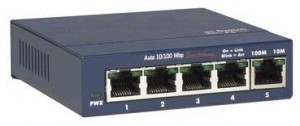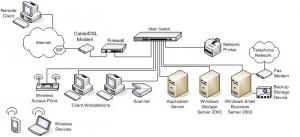NETWORK SWITCH
Switches are the most fundamental part of network. Switches allow different nodes (a network connection point or a computer), i.e- a switch is an intermediate station which interconnects the communication links and subnetworks to enable transmission of data between the end stations. Switching involves transferring information, such as digital data packets or frames, among entities of the network. A switch functions as an interchanger and provides path switching for data being transported over a network computer in a network to communicate directly with one another in a smooth and efficient manner. Network switch is a small hardware device that joins multiple computers together within one local area network (LAN). Technically, network switches operate at layer two (Data Link Layer) of the OSI model. The connectivity provided by switches are also known as network bridges. A network Typically, a switch supports one network protocol (e.g. Ethernet), meaning that the switch manages data in a particular format.
A typical network consists of:
1) Nodes, or computers.
2) A medium for connection, either wired or wireless.
3) Special network equipment, such as routers or hubs.
We can connect a number of peripherals like Wireless Access Point, Workstation, Modem, Firewall, printer, Scanner or other devices with the help of a Network switch, as shown in the figure.
A network switch for routing packets between network buses includes a set of input switch ports for receiving packets arriving on the network buses, a set of output switch ports for forwarding packets outward on the network buses, and a switch fabric for routing packets between the input and output switch ports. Each input switch port includes a memory for storing packets arriving on a network until the switch fabric can forward them to an output switch port.
Broadly Switches are classified into two types:
1) Manageable: Such type of switch can be configured by console. We can restrict the data speed on a particular port number. We can regulate the uplink and data transmission rate by monitoring and managing the network traffic.
2) Un-manageable: such type of switches cannot be configured. They simply run on a power supply and just provides the connectivity to remote location.
Different models of network switches support differing numbers of connected devices. Most consumer-grade network switches provide either four or eight connections for Ethernet devices.
Switches may operate at one or more OSI layers, including physical, data link, network, or transport (i.e., end-to-end). A device that operates simultaneously at more than one of these layers is known as a multilayer switch.









October 18th, 2010 at
[…] This post was mentioned on Twitter by Ron Gibson and iWatchSystems LLC, iWatchSystems LLC. iWatchSystems LLC said: NETWORK SWITCH http://dlvr.it/7BD5N […]
October 26th, 2010 at
Great Post!…
[…] I found your entry interesting thus I’ve added a Trackback to it on my weblog […]…
[…]…
October 26th, 2010 at
Thanks for your appreciation my friend. keep visiting the Weblog and do post comments and suggestions.
October 28th, 2010 at
[…] NETWORK SWITCH | Technical […]